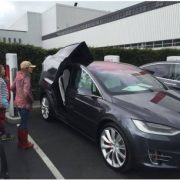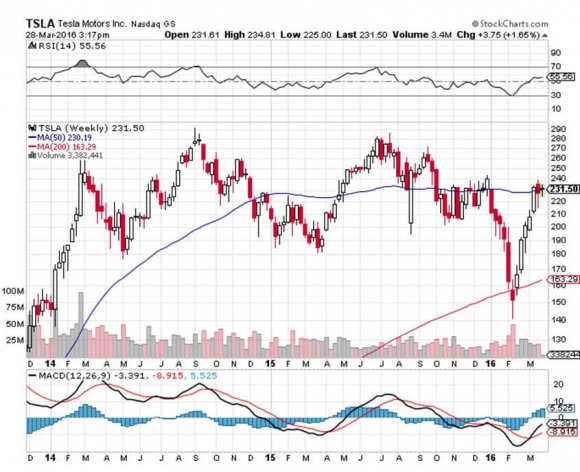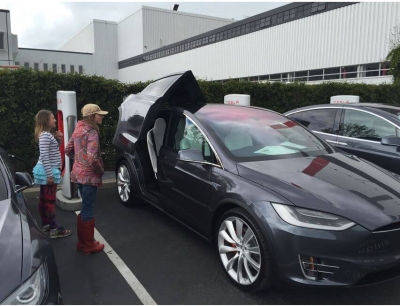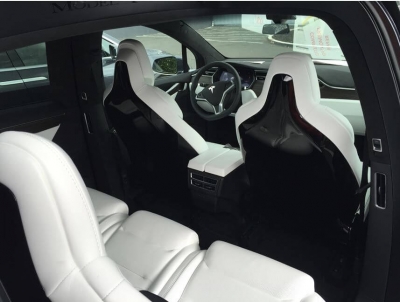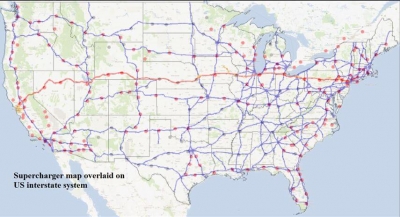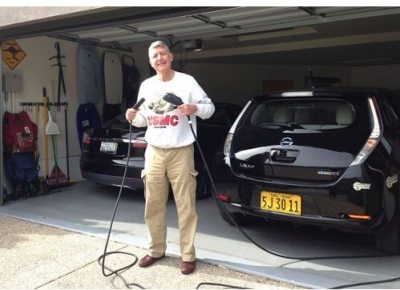I stopped by Tesla?s (TSLA) Fremont, California factory last week to test drive my new high performance Model X SUV and noticed something interesting.
There was major new construction under way in the customer delivery area.
That was to be expected, since the company has already announced that they plan to boost production of their sleek, ultra high tech Model-S sedan from 51,000 units this year to 93,000. It seems doable, since there is still a four-month waiting list to obtain a new vehicle.
However, something didn?t fit. They weren?t doubling the car delivery area. They were increasing it by TEN TIMES! Clearly, something much larger was afoot.
After chatting up the staff inside, I learned what was really going on. On Thursday, March 31, CEO and founder Elon Musk will unveil the next generation all electric Tesla 3 at the Hawthorne, California facility. The move promises to upend the global automobile industry.
The $35,000 four-passenger car will get a 200 mile range and require almost no maintenance for its entire life. The batteries will offer an eight-year minimum guarantee.
The vehicles can be recharged by plugging in at home, with 90% discounts for charges between 12:00 and 7:00 AM (in California).? At that rate, your fuel cost works out to the equivalent of 4 cents per gallon. They can also be juiced up for free in 30 minutes at Tesla?s 200-station national supercharger network (see map below).
The cars will be fully equipped with self driving technology, although the system has yet to be fully activated pending regulatory and insurance issues. The first vehicles will be delivered in 2017.
However, Elon has been late with every car he has delivered so far, so 2018 is more realistic. Customers don?t care. They would rather have delayed perfection than an early, buggy beta model.
Tesla will start accepting $1,000 deposits for the Model 3 online from April 1. The company expects to sell 10,000 on the first day.
The Tesla 3 has always been the final goal of Musk?s grand vision to build a carbon free global economy. The Tesla Roadster and the Model S-1 were really just test beds to develop a mass-market technology. Now it has finally arrived.
Tesla plans to be producing 500,000 Model 3?s within five years. Beyond that, the sky is the limit. The $6 billion gigafactory, its construction well ahead of schedule (I?ve flown over it), promises to deliver the lithium ion battery packs to make these lofty goals possible. A second plant is planned, possibly in Texas.
And here is the stock play in Tesla. The company is not expected to earn real, non subsidized, accounting gimmick free earnings for several years. But what is ownership of the global car market in a decade worth today?
Tesla sales this year will only account for 0.55% of total US auto production. But they are easily a decade ahead of any potential competitor in the all electric field, be they American, German, Korean, or Japanese. And they are increasing that lead at an astounding pace.
With the highest quality product, the best electric car brand recognition, the greatest range, and the lowest price point, Tesla should own the global car market by 2025. For decades, their only possible limitation will be the number of cars they can produce, except possibly during recessions.
Ad this to the plunging price of solar power, and the cost advantages increase even further. I am already powering my own Tesla S-1 off of my solar panels, and will be adding a second Model X shortly.
It all makes established automakers toast in the 2020?s like General Motors (GM), Daimler Benz (DDAIY), Toyota (TM), and Nissan Motors (NSANY)
You can forget about chasing the stock up here. The Model 3 launch has already been fully discounted by the meteoric 71.4% gain in the stock since February 11.
However, Tesla remains a major holding in long term value funds like Ron Baron?s Baron Capital, and Fidelity. They see further tenfold gains in the share price from here.
The electric power source is, in fact, the least important aspect of the Tesla cars. Here are 16 reasons that are more important:
1) The vehicles have 75% fewer parts than any other, massively reducing production costs. The drive train has 11 parts, compared to over 1,500 for conventional gasoline powered transportation. Tour the factory and it is eerily silent. There are almost no people, just a handful who service the German robots that put these things together.
2) No maintenance is required, as any engineer will tell you about electric motors. You just rotate the tires every 6,000 miles.
3) This means that no dealer network is required. There is nothing to fix, no parts to sell.
4) If you do need to repair something, usually it can be done over the phone. Rebooting the computer addresses most issues. If not, they will send a van to do a repair at your house for free.
5) The car runs at room temperature, not the 500 degrees in standard internal combustion cars. This means that the parts last forever.
6) The car is connected to the Internet 24/7. Once a month it upgrades its own software when you are sleeping. You jump in the car the next morning and a message appears on your screen saying, ?We just upgraded the following 20 Apps.? This is the first car I ever owned that improved itself with age, as I do myself.
7) This is how most of the recalls have been done as well, over the Internet while you are sleeping.
8) If you need to recharge at a public station, it is free. Tesla has its own national network of superchargers that will top you up in minutes, and allow you to drive across the country (see map below). But hotels and businesses have figured out that electric car drivers are the kind of big spending customers they want to attract. So public stations have been multiplying like rabbits. When I first started driving my Nissan Leaf in 2010 there were only 25 charging stations in the Bay Area. There are now over 1,000. They even have them at Costco, Wal-Mart, and McDonalds.
9) No engine means a lot more space for other things, like storage. You get two trunks in the Model-S, a generous one behind, and a ?frunk? in front.
10) Drive an electric car in California, and you are treated like visiting royalty. You can drive in the HOV commuter lanes as a single driver. This won?t last forever, but it?s a nice perk now.
11) There is a large and growing market for all American made products. Tesla has a far higher percentage of US parts (100%) than any of the big three.
12) Since almost every part is made on site at the Fremont factory, supply line disruptions are eliminated. Most American cars are over dependent on Asian supply lines for parts and frequently fall victim to disruptions, like floods and tidal waves.
13) There are almost no controls, providing for more cost savings. Except for the drive train, windows, and turn signals, all vehicle controls are on the touch screen, like a giant iPhone 6 plus.
14) A number of readers have argued that the Tesla really runs on coal, as this is still the source of 36% of the US power supply. However, if you program the car between midnight and 7:00 AM (one of my ideas that Tesla adopted in a recent upgrade), you are using electricity generated by the utilities to maintain grid integrity at night that otherwise goes unused and wasted. How much power is wasted like this in the US every night? Enough to recharge 150 million cars per night!
15) With a waiting list for all new Tesla products, it does not need to advertise. The Detroit Big Three spent $50 billion on advertising last year. Ouch!
16) Oh yes, the car is good for the environment, a big political issue for at least half the country. When these cars become cheaper than conventional gasoline cars with oil at $26 a barrel, the entire country will switch over.
See you in Fremont.

